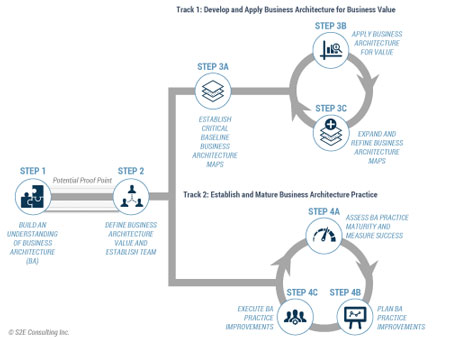Establishing a successful, sustainable business architecture practice is a journey that takes time, especially within large organizations. While there are always many ways to achieve an outcome, Figure 1 shows a practical and well-tested path to accelerate the process of establishing and maturing a practice.

Figure 1 – Path to a successful business architecture practice.
The first two steps provide a foundation for all others that follow and it is difficult to succeed when these initial steps are not executed well. The path starts with building an understanding of business architecture, including the scope of what it is and is not, how it can be used, and how it can be integrated into an organization. The next step is defining business architecture value to the organization and establishing the team. Business architecture value must be clearly, simply, and consistently articulated to all stakeholders, including the business architecture team itself. This will serve as a compass for all business architecture activities, informing decisions and priorities. To establish the team, organizations create a charter, define and implement an organizational structure, and hire team members.
After establishing the business architecture value and team, the rest of the path proceeds along two parallel tracks, both of which are important and related. The first track is the primary one for developing and applying business architecture for business value. The loop within this track will continue indefinitely, though the applications for business architecture will likely grow in scope and complexity over time. The second track is for establishing and maturing the business architecture practice, which includes all supporting aspects, such as developing people, governing methods and practices, managing tools, integrating into the organization, and measuring success. This loop will also continue indefinitely, but once a practice reaches a state of desired maturity, the focus becomes more on continuous improvement versus large steps of advancement.
Within Track 1, Step 3A establishes critical baseline business architecture maps, such as an enterprise capability map, basic information map, and core value streams. Of course, the entire business architecture baseline could be mapped initially, but this is not always feasible for some organizations for various reasons. Business architecture is then put into action quickly in Step 3B to start providing business value, in alignment with the vision defined in Step 2. Step 3C continually expands the business architecture baseline by adding new types of mappings, such as for strategies, products, and initiatives, and it also refines the content of the entire knowledgebase as needed. The expansion activities in Step 3C are typically prioritized based on the types of scenarios in which business architecture will be applied during Step 3B, particularly in the case of a new practice where limited resources are available.
Within Track 2, there is a continual loop for maturing the business architecture practice that starts in Step 4A with an assessment of the current practice maturity and measurement of its success. Along with the practice of goal setting, this leads to Step 4B, which is where enhancements are planned for the practice over the next horizon. Step 4C executes on those changes, which are measured again in Step 4A. This loop typically occurs as an annual planning process, where measurement, goal setting, and next-horizon planning for the business architecture practice is done at the end of the year, and then practice enhancements are executed upon during the following year. It is critically important that the planned practice enhancements align with how business architecture is being applied in Step 3B. The most practical approach to building and scaling a practice is to do just enough, just in time, in order to support the current business architecture scenarios.
Some organizations are not able initially to obtain full buy-in to establish a business architecture team as described in Step 2. In these cases, they may need an additional period of time to prove the value and gain support. Some basic baseline business architecture maps may still be built (but not to full detail) and then applied to an initial scenario or two. During this proving period, it is still important to build the maps with an enterprise and long-term-usage perspective, to select scenarios that will demonstrate the true value of business architecture (e.g., cross-business unit), to execute quickly and well, and to share the success to build advocacy. Once achieving this, Step 2 can begin.




